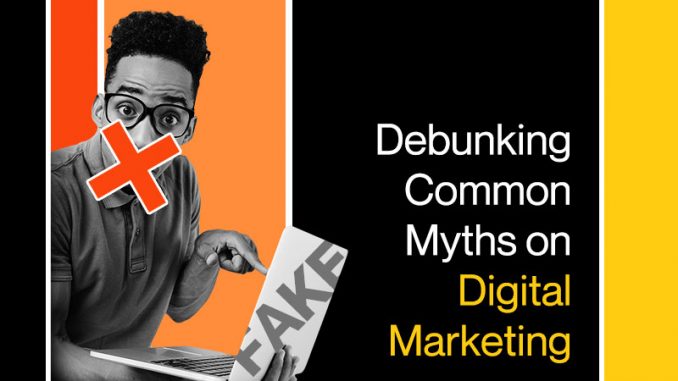
It’s not uncommon to hear a lot of misconceptions about digital marketing.
Even with the steady growth of digital marketing as a way to reach audiences, there are still a lot of myths out there.
In this guide, we take a look at common myths in digital marketing and what we can do about them.
Digital Marketing Only Appeals to the Younger Generation
Digital marketing platforms have become accessible to almost anyone of any age group. If this is combined with the number of people who own smart devices, this statement should be considered a complete myth.
As long as target prospects are present in one digital medium, they can be reached, targeted and prospected.
At the end of the day, digital marketing is just a general avenue to reach audiences.
Optimizing Everything Once is Enough
Digital marketing is organic so this means that it is constantly changing as people and the times change.
This means working on optimizing something once is never enough.
People who’ve fully optimized they’re digital marketing presence still have to be constantly posting and running campaigns to keep up with the times.
Remember, engagement and activity are critical to your success in digital marketing.
It’s highly recommended that campaigns be monitored and measured for their success rates.
You Need to Have a Large Social Media Ad Budget
While it’s true that social media networks are reliant on ad spending to grow their revenues, that doesn’t mean that startups need to be shelling out top dollar to get noticed online.
Spending money on social media ads makes sense if the customer can afford it, but there are a lot of corporations out there who also maintain organic campaigns alongside their paid ones.
The reasoning behind it is simple: organic social media campaigns work.
Here’s why.
Social media platforms still need normal traffic and viral posts to keep people on their platforms. The longer that a user stays on the platform looking at the free stuff, the more likely it is that they will come across an ad hosted by the platform.
They can’t just show ads all the time or else user experience will tank. They still need to prioritize organic content.
This is the same reason why a lot of social media managers will advise going after organic viral campaigns because social media platforms also benefit from this – it gets people to stay for longer.
Negative Comments are Bad
Negative comments are actually good.
There is no such thing as a perfect product and you can’t please everybody. Keeping negative comments right where they are a good thing because they tell prospects that you are leaving your platform open to criticism.
What’s important is how these comments are addressed.
There has to be a customer experience team ready to address concerns and respond to people.
Content Doesn’t Really Help
Content helps and this is especially true for B2B businesses.
Most B2B buyers start their journey by doing their research online and if they happen to land on your content, they’ll use it as a jump off point to learn more about the company.
Just because a particular blog post’s CTA or “Call” button isn’t being clicked doesn’t mean it isn’t contributing to the overall growth of a company.
Moreover, the more you can educate a prospect regarding a certain topic that is related to the product that you’re selling that provides them with a solution, the more likely it is that they will turn to you for the purchase.
Content has been usually used for lead nurturing and for passive lead generation, and this is growing to be one of the best ways to land stray leads on LinkedIn or using SEO.
My Industry Can’t Use Social Media
Every industry can benefit from social media, and there’s no industry too boring that can’t leverage platforms such as Facebook or LinkedIn for leads.
Marketers might not be able to launch viral campaigns for industries that are too technical, but they can still use these platforms for lead generation.
Take for example LinkedIn, being the largest professional social media network in the world, it has often been leveraged for prospecting even in the most technical of industries given that almost every professional is on it.
Another way to leverage social media is to establish the brand or the brand ambassador as a thought leader in hyper-specific niches. This allows them to command large audiences and encourage them towards a brand.
We’ve seen this with the rise of B2B influencers and thought leaders on LinkedIn.
Remarketing and Retargeting is Invasive
Using cookies and pixels, doesn’t have to be invasive.
The problem with many retargeting campaigns is that they can get creepy given the amount of personalization that’s put in making prospects feel like they’re being followed around.
The goal of methods such as retargeting is to gently guide a prospect into a funnel and not focus on a hard sell.
A gentle approach is what people expect, the more marketers push for a sale right away, the harder it becomes to convince a prospect to convert at the end of the funnel.
This is not a complete list of digital marketing myths, there are a lot more out there that are being spread because of faulty information.
Digital marketing still remains to be one of the prime ways to increase market share, revitalize lead generation, and grow organizations. It shouldn’t be set aside.

Leave a Reply